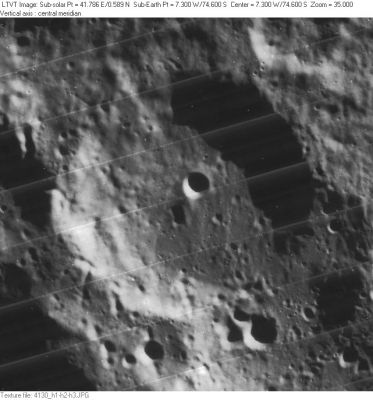Short
Contents
Short
|
Lat: 74.6°S, Long: 7.3°W, Diam: 70 km, Depth: 3.37 km, Rükl: 73 |
Table of Contents

LO-IV-130H Short is regarded as overlaying 71-km diameter Short B, a somewhat vague structure on the lower right. The circular crater on the floor is unnamed.
Images
LPOD Photo Gallery Lunar Orbiter Images Apollo Images
Maps
(LAC zone 137C1) USGS Digital Atlas PDF
Description
Description: Elger
(IAU Directions) SHORT.--A fine but foreshortened ring-plain of oblong shape, squeezed in between Moretus and Newton. It is about 30 miles in diameter, and on the S.W., where its border and that of Newton are in common, it rises nearly 17,000 feet above the interior, which includes, according to Neison, a small central hill. Schmidt shows a crater on the N. side of the floor.
Description: Wikipedia
Additional Information
Depth data from Kurt Fisher database
- Westfall, 2000: 3.37 km
- Viscardy, 1985: 5.7 km
- Cherrington, 1969: 4.2 km
Nomenclature
James; Scottish mathematician, optician (1710-1768).
LPOD Articles
Bibliography
James Short in the Sourcebook Project (William R. Corliss)
(articles in which James Short is mentioned)
- In Mysterious Universe, a handbook of astronomical anomalies (1979) :
- Page 138: The Satellite of Venus (T.W.Webb, Nature, 1876).
- Page 142: The Supposed Satellite of Venus (Observatory, 1887).
Note: these strange articles are from the days when a natural satellite in orbit around Venus was still seen as a possibility... (or perhaps not?). Anyway, the observing eyes of lots of professional and amateur astronomers were glued to the eyepieces of their telescopes. Perhaps a bit too much glued, because most of them didn't observe the supposed "natural" satellite (called "Neith"), but... rather the unexpected ghost image of the bright Venus itself, reflected between the lenses of the telescope's eyepiece! (a visual side effect created by poor optics, or...??). - DannyCaes DannyCaes Apr 19, 2015
- We could ask questions about telescopic observers of binary and multiple star systems. Were they really observing binary and multiple stars, or were most of them just adjacent ghost images of singular bright stars? - DannyCaes DannyCaes Apr 19, 2015
This page has been edited 1 times. The last modification was made by - tychocrater tychocrater on Jun 13, 2009 3:24 pm - afx3u2